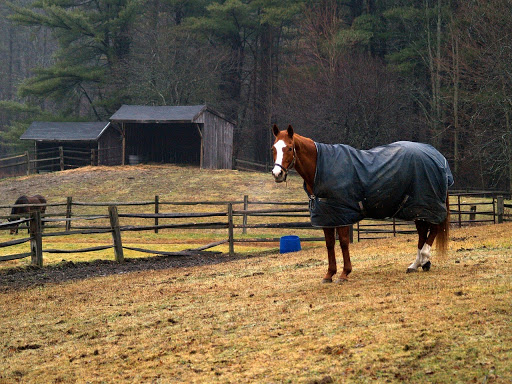Horse Blankets: What You Need to Know
When the weather is getting colder, a warm blanket is important for your horse’s health. The sheet is usually made of firm fabric and it’s tacked with fasteners, belts, or velcro. Different blanket types are used for specific purposes.
So, let’s get all the nuts and bolts on blanketing a horse to cover your equine companion.
Horse Blanket Types
There are several types of horse blankets: turnout, stable, quarter sheets, and coolers. Depending on your horse’s needs and climate conditions you can pick the perfect option.
Turnout blankets are designed for any weather as they are water-resistant, wind-proof, and come with fleece lining. In addition, there are horse blankets with high withers and with a hood over the head. Such horse sheets also protect the horse belly from dirt.
Stable blankets help to protect the horse from dirt and dust as well as to keep warm after work.
While horseback riding, a quarter sheet can be used. The inveterate equestrian David Garcia recommends to tack up the quarter blanket under the horse saddle or on a limited body part like shoulders or croup. This is made to warm up your companion’s muscles when riding in cold weather.
Coolers are used primarily for sport horses. Cotton or wool paddings are used to prevent hypothermia of the horse. If your hooved friend excessively sweats after training or during a competition, use cooling blankets that have shock-absorption features. The sheet wicks moisture quickly to dry out the horse.
There are also fly sheets that are useful in summer to protect from insects. Equine manufacturers often treat the mesh with repellents. Such a horse blanket may also come with a fly mask.
How to Tell If Your Horse Is Cold?
If your horse is cold, it starts shaking. That’s a reflex action of the muscles to generate more heat. Generally, it’s not dangerous but over a few hours of shivering the horse is deprived of energy, its temperature drops, and it becomes vulnerable to infections.
When it’s cold outside, clipped horses with a light blanket may freeze badly. especially when they are unable to move properly. In a too dense blanket, a horse could get a chill from its own sweat or a wet blanket. That’s because the sheet presses down the wool and retains moisture near the body.
It’s crucial to remember that a horse blanket is not optimal protection in cold weather, as it cannot shelter a horse from rain and wind like a covered shed and wind protection.

Overheating Horses
Sweat is the most noticeable sign of overheating. First, the equine sweats under the blanket, then on the neck and behind the ears. Overheating is a common problem for horses that’s caused by turning out with a thick blanket designed for colder conditions.
The temperature swing between daytime and night can be up to 50 degrees, thus the animal gets hot under a warm horse blanket. In chill weather, a tacked horse can sweat easily while working and then freeze badly under a wet sheet.
On days when the temperature ranges greatly it’s better to wear a thinner blanket. The horse can keep warm by working sheltered from the wind or standing in the sun. But if it’s hot, your hooved friend has no way to get rid of it.
What Blanket To Wear After Work
After work, you should cover your horse when it has already taken its breath and dried out. A regular blanket will retain moisture near the skin, increasing the drying time of the coat. And the horse’s body temperature will get back to normal. To speed up the process you can dry the horse with a towel.
Another way is to tack the horse with a woolen or acrylic blanket. If you cover the horse with a windproof sheet, it makes sense to put some shavings or hay under it as an absorbent layer. Besides, it will provide the necessary air circulation.
How to Maintain a Horse Blanket
Like any piece of horse equipment, a horse blanket also requires special care. Firstly, you need to check all the fasteners and seams regularly. Secondly, the blankets should be shaken out after each use, ventilated, and dried. They also need to be washed with non-toxic cleaners. Jute horse rugs have to be thoroughly cleaned with a stiff brush.
The Bottom Line
A proper horse blanket is a helpful horse tack that is needed in various conditions. There are loads of horse sheet types available, so you can choose the perfect one for your companion. When blanketing a horse, check that your hooved friend is not getting cold or overheated.
While choosing a blanket for your friend, find out its purpose first, and pick the proper horse blanket size. Fitting a horse sheet affects its comfort and protection.
featured photo credit: image by joannafotograf on Pixabay
Enjoyed this article? Here are three more to help you:
How To Help Your Horse’s Winter Colic
Horse Clicker Training with Amanda Martin on the Real Dr. Doolittle Show™
12 Things You Didn’t Know About Elise Gaston Chand and Horse Whispering
The post Horse Blankets: What You Need to Know appeared first on Val Heart.
source https://valheart.com/horse-blankets-what-you-need-to-know/
No comments:
Post a Comment